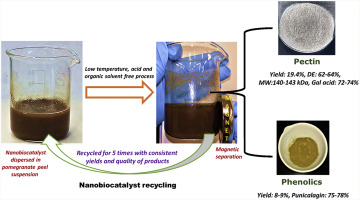当前位置:
X-MOL 学术
›
Food Hydrocoll.
›
论文详情
Our official English website, www.x-mol.net, welcomes your
feedback! (Note: you will need to create a separate account there.)
Recyclable enzymatic recovery of pectin and punicalagin rich phenolics from waste pomegranate peels using magnetic nanobiocatalyst
Food Hydrocolloids ( IF 11.0 ) Pub Date : 2019-04-01 , DOI: 10.1016/j.foodhyd.2018.11.009 Sachin Talekar , Antonio F. Patti , R. Vijayraghavan , Amit Arora
Food Hydrocolloids ( IF 11.0 ) Pub Date : 2019-04-01 , DOI: 10.1016/j.foodhyd.2018.11.009 Sachin Talekar , Antonio F. Patti , R. Vijayraghavan , Amit Arora

|
Abstract We demonstrate a novel recyclable enzymatic approach of extraction of pectin and punicalagin rich phenolics from the waste pomegranate peels (WPP) using the magnetic nanobiocatalyst technology. First, the cellulase was cross-linked with the iron oxide magnetic nanoparticles using glutaraldehyde to prepare the magnetic nanobiocatalyst which was characterized using FT-IR, FE-SEM, and TEM. Then, ultrasonically pre-treated WPP were hydrolyzed with the magnetic nanobiocatalyst at cellulase loading of 75 U/g of peel powder, pH 6 and 50 °C for 5 h to obtain maximum recovery of pectin (19.4%) and total phenolics (8.8%) comparable to non-green conventional methods. The magnetic nanobiocatalyst was easily recovered by the application of a magnetic field and recycled for five cycles with no change in pectin and total phenolics yields and cellulase activity. In addition, IR, 1H NMR, and TGA analysis showed that the chemical nature of pectin was the same in each cycle. The uronic acid content (72–74%), degree of esterification (62–64%), molecular weight (140–143 kDa) and polydispersity (1.5–1.6) of pectin from each cycle were also in the similar range. The total phenolics obtained in each cycle were rich in punicalagin (75–78% of total phenolics) with similar content of 6.42–6.65 g/100 g WPP. These results indicated the excellent stability and reusability of the cellulase magnetic nanobiocatalyst for the recovery of WPP pectin and phenolics of consistent yield and chemical nature/composition.
中文翻译:

使用磁性纳米生物催化剂从废弃石榴皮中可回收酶促回收果胶和富含安石榴苷的酚类物质
摘要 我们展示了一种使用磁性纳米生物催化剂技术从废石榴皮 (WPP) 中提取富含果胶和安石榴苷的酚类物质的新型可回收酶法。首先,使用戊二醛将纤维素酶与氧化铁磁性纳米粒子交联以制备磁性纳米生物催化剂,并使用 FT-IR、FE-SEM 和 TEM 进行表征。然后,超声波预处理的 WPP 用磁性纳米生物催化剂水解,纤维素酶负载量为 75 U/g 果皮粉,pH 6 和 50 °C 5 小时,以获得最大的果胶回收率(19.4%)和总酚类物质(8.8%) ) 可与非绿色传统方法相媲美。磁性纳米生物催化剂通过施加磁场很容易回收并循环使用五个循环,果胶和总酚类产量和纤维素酶活性没有变化。此外,IR、1H NMR 和 TGA 分析表明,果胶的化学性质在每个循环中都是相同的。每个循环中果胶的糖醛酸含量 (72–74%)、酯化度 (62–64%)、分子量 (140–143 kDa) 和多分散性 (1.5–1.6) 也处于相似范围内。在每个循环中获得的总酚类物质富含安石榴苷(占总酚类物质的 75-78%),含量相似,为 6.42-6.65 g/100 g WPP。这些结果表明纤维素酶磁性纳米生物催化剂具有优异的稳定性和可重复使用性,用于回收 WPP 果胶和酚类物质,具有一致的产量和化学性质/组成。IR、1H NMR 和 TGA 分析表明,每个循环中果胶的化学性质相同。每个循环中果胶的糖醛酸含量 (72–74%)、酯化度 (62–64%)、分子量 (140–143 kDa) 和多分散性 (1.5–1.6) 也处于相似范围内。在每个循环中获得的总酚类物质富含安石榴苷(占总酚类物质的 75-78%),含量相似,为 6.42-6.65 g/100 g WPP。这些结果表明纤维素酶磁性纳米生物催化剂具有优异的稳定性和可重复使用性,用于回收 WPP 果胶和酚类物质,具有一致的产量和化学性质/组成。IR、1H NMR 和 TGA 分析表明,每个循环中果胶的化学性质相同。每个循环中果胶的糖醛酸含量 (72–74%)、酯化度 (62–64%)、分子量 (140–143 kDa) 和多分散性 (1.5–1.6) 也处于相似范围内。在每个循环中获得的总酚类物质富含安石榴苷(占总酚类物质的 75-78%),含量相似,为 6.42-6.65 g/100 g WPP。这些结果表明纤维素酶磁性纳米生物催化剂具有优异的稳定性和可重复使用性,用于回收 WPP 果胶和酚类物质,具有一致的产量和化学性质/组成。6) 来自每个循环的果胶也在相似的范围内。在每个循环中获得的总酚类物质富含安石榴苷(占总酚类物质的 75-78%),含量相似,为 6.42-6.65 g/100 g WPP。这些结果表明纤维素酶磁性纳米生物催化剂具有优异的稳定性和可重复使用性,用于回收 WPP 果胶和酚类物质,具有一致的产量和化学性质/组成。6) 来自每个循环的果胶也在相似的范围内。在每个循环中获得的总酚类物质富含安石榴苷(占总酚类物质的 75-78%),含量相似,为 6.42-6.65 g/100 g WPP。这些结果表明纤维素酶磁性纳米生物催化剂具有优异的稳定性和可重复使用性,用于回收 WPP 果胶和酚类物质,具有一致的产量和化学性质/组成。
更新日期:2019-04-01
中文翻译:

使用磁性纳米生物催化剂从废弃石榴皮中可回收酶促回收果胶和富含安石榴苷的酚类物质
摘要 我们展示了一种使用磁性纳米生物催化剂技术从废石榴皮 (WPP) 中提取富含果胶和安石榴苷的酚类物质的新型可回收酶法。首先,使用戊二醛将纤维素酶与氧化铁磁性纳米粒子交联以制备磁性纳米生物催化剂,并使用 FT-IR、FE-SEM 和 TEM 进行表征。然后,超声波预处理的 WPP 用磁性纳米生物催化剂水解,纤维素酶负载量为 75 U/g 果皮粉,pH 6 和 50 °C 5 小时,以获得最大的果胶回收率(19.4%)和总酚类物质(8.8%) ) 可与非绿色传统方法相媲美。磁性纳米生物催化剂通过施加磁场很容易回收并循环使用五个循环,果胶和总酚类产量和纤维素酶活性没有变化。此外,IR、1H NMR 和 TGA 分析表明,果胶的化学性质在每个循环中都是相同的。每个循环中果胶的糖醛酸含量 (72–74%)、酯化度 (62–64%)、分子量 (140–143 kDa) 和多分散性 (1.5–1.6) 也处于相似范围内。在每个循环中获得的总酚类物质富含安石榴苷(占总酚类物质的 75-78%),含量相似,为 6.42-6.65 g/100 g WPP。这些结果表明纤维素酶磁性纳米生物催化剂具有优异的稳定性和可重复使用性,用于回收 WPP 果胶和酚类物质,具有一致的产量和化学性质/组成。IR、1H NMR 和 TGA 分析表明,每个循环中果胶的化学性质相同。每个循环中果胶的糖醛酸含量 (72–74%)、酯化度 (62–64%)、分子量 (140–143 kDa) 和多分散性 (1.5–1.6) 也处于相似范围内。在每个循环中获得的总酚类物质富含安石榴苷(占总酚类物质的 75-78%),含量相似,为 6.42-6.65 g/100 g WPP。这些结果表明纤维素酶磁性纳米生物催化剂具有优异的稳定性和可重复使用性,用于回收 WPP 果胶和酚类物质,具有一致的产量和化学性质/组成。IR、1H NMR 和 TGA 分析表明,每个循环中果胶的化学性质相同。每个循环中果胶的糖醛酸含量 (72–74%)、酯化度 (62–64%)、分子量 (140–143 kDa) 和多分散性 (1.5–1.6) 也处于相似范围内。在每个循环中获得的总酚类物质富含安石榴苷(占总酚类物质的 75-78%),含量相似,为 6.42-6.65 g/100 g WPP。这些结果表明纤维素酶磁性纳米生物催化剂具有优异的稳定性和可重复使用性,用于回收 WPP 果胶和酚类物质,具有一致的产量和化学性质/组成。6) 来自每个循环的果胶也在相似的范围内。在每个循环中获得的总酚类物质富含安石榴苷(占总酚类物质的 75-78%),含量相似,为 6.42-6.65 g/100 g WPP。这些结果表明纤维素酶磁性纳米生物催化剂具有优异的稳定性和可重复使用性,用于回收 WPP 果胶和酚类物质,具有一致的产量和化学性质/组成。6) 来自每个循环的果胶也在相似的范围内。在每个循环中获得的总酚类物质富含安石榴苷(占总酚类物质的 75-78%),含量相似,为 6.42-6.65 g/100 g WPP。这些结果表明纤维素酶磁性纳米生物催化剂具有优异的稳定性和可重复使用性,用于回收 WPP 果胶和酚类物质,具有一致的产量和化学性质/组成。











































 京公网安备 11010802027423号
京公网安备 11010802027423号